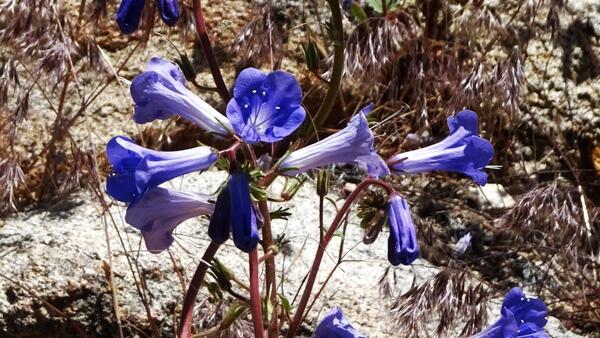The complexity of desert wildflowers
"I hold no preference among flowers, so long as they are wild, free, spontaneous." — Edward Abbey
By CAMERON BARROWS
Desert wildflowers illustrate the often-hidden biodiversity of deserts. For months, sometimes years on end, deserts are bathed in a subtle yet beautiful kaleidoscope of beige, tan, gray, and brown. Then, when the rain finally comes, and if enough comes and at the right time, deserts become a canvas for a seemingly endless variation of purples, yellows, blues, oranges, pinks, and whites. The colors bring out masses of humans who otherwise might disdain the beige, tan, gray, and browns, but revel in the ephemeral, breathtaking beauty of desert wildflowers. Of course, the wildflowers do not put on their show for us, they have their own, self-serving agenda.
Desert flowers exist for just one purpose — reproduction. To produce genetically heterogeneous offspring that will have the tools to survive the challenges of a desert existence cross fertilization. To that end, flowers have enlisted a diversity of creatures to serve them: bees, butterflies, moths, flies, beetles, and wasps, collectively the pollinator guild, that often have a similar ephemeral existence, creatures that move pollen from one plant to another plant of the same species. To achieve that goal, wildflowers offer nectar or even surplus pollen as payment for that transfer from one plant to another. But not too much pollen or too much nectar. If provided with too much succor their “servants” would gorge themselves to satiation at one flower, never needing to move to another plant. The flowers “want” their armies of pollinators to move on, provide them with just a snack but then move to the next plant. What might seem simple enough at first blush, can be wondrously complex.
While non-native honeybees are the epitome of pollination generalists, they are inefficient for the needs the desert wildflowers. Native pollinators have often become specialists, efficiently servicing just one species at a time. To work most efficiently, after a tantalizing snack of nectar or pollen or both, the pollinator should move on to another plant of the same species, thus ensuring cross fertilization. Moving to a different flower of a different species provides no benefit to the plant. A plant must provide enough of a snack to “train” the pollinator to seek out another plant of the same species, but not too much so that it stays on the same flower, or even the same individual plant.
When we look at fields of desert wildflowers, two colors seem to dominate, purple and golden yellow. One might wonder why, and if there might be some advantage for multiple plant species to share similar colors? It seems at least possible that by using the same color palette, flowers could create a larger “target” for pollinators searching for food. Whereas a few scattered flowers could be challenging to find, large fields would be beacons, signaling to those mobile pollinators that snacks are being served. Once having arrived at a wildflower patch, other cues such as pheromones, nectar scents, or unique ultraviolet signatures, seen by pollinators but oblivious to us, could allow pollinators to focus on specific species. That focus or specialization might then facilitate the development of new pollinator species, so that wildflower diversity would beget pollinator diversity. Along with a diverse array of pollinators, there will be a similarly diverse array of parasitic and predatory insects. Parasitic wasps, along with crab spiders and assassin bugs add to the biodiversity initiated by the existence of native wildflowers.
All of these interconnected species, plants, pollinators, parasites, and predators, also have to contend with the ephemeral, stochastic nature of desert rain. Multi-year droughts, so common and unpredictable in desert biomes, seem so able to squash out the existence of biodiversity. But it doesn’t. For annual plants, their seeds are stored in the soil waiting for enough rain to stimulate germination. When that rain comes, not all the seeds do germinate, hedging against the promise of enough rain to complete their lifecycle. If the seed misjudged the sufficiency of rain, if the rains are insufficient for plants to complete their lifecycle from germination to flowering to setting a new seed cohort into the soil, there is always a large cohort of seeds that didn’t germinate and will be available next time when enough rain does fall. But then how do the native pollinators contend with the erratic nature of desert rain? At least for some butterflies, their caterpillars can live in the soil, in a diapause state akin to brumation (cold-blooded hibernation), waiting years for the right conditions for pupating into a butterfly. Studies have shown that caterpillars are capable of becoming temporarily active and assessing the availability of food plants every spring. If food is found wanting, they can go back into diapause repeatedly for as many as six years (or more).
The existence of desert wildflowers and the associated web of life associated with those flowers may seem inexplicable, like magic. I would argue that the more we understand, the more wondrous the desert becomes. The more we understand the complexity of nature, the more we value its continued existence.
Nullius in verba
Go outside, tip your hat to a chuckwalla (and a cactus), think like a mountain, and be safe

